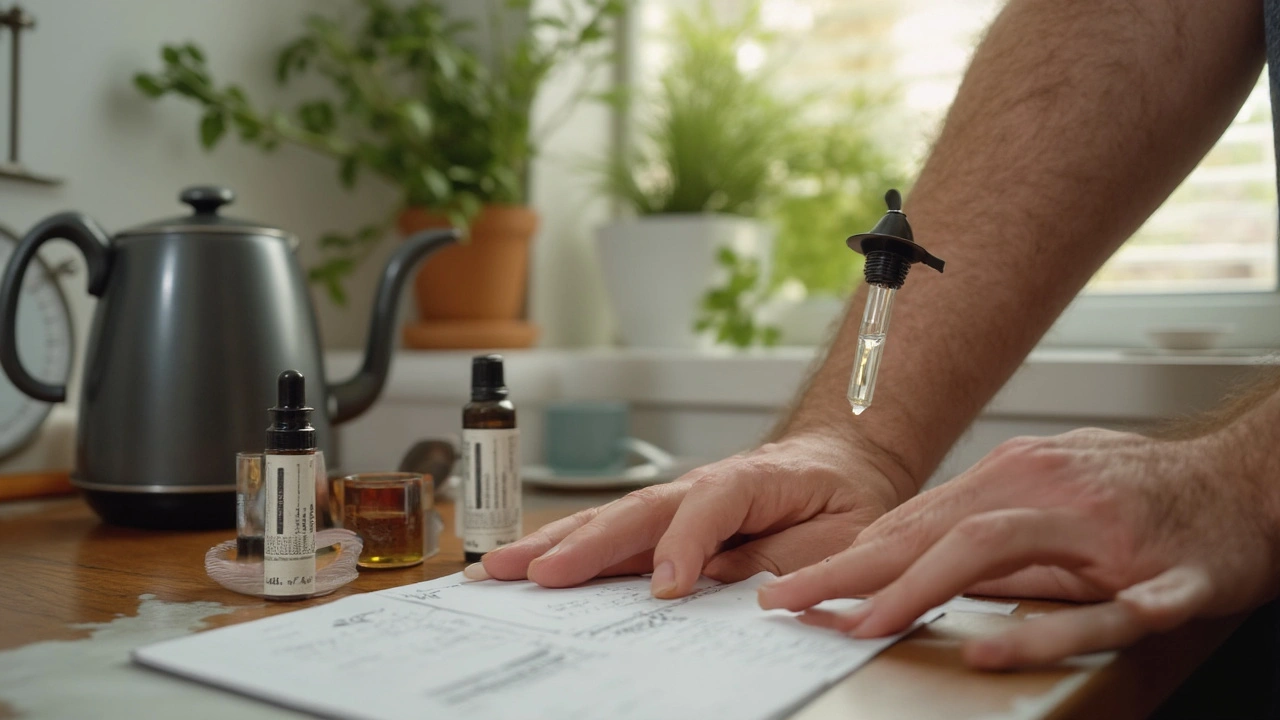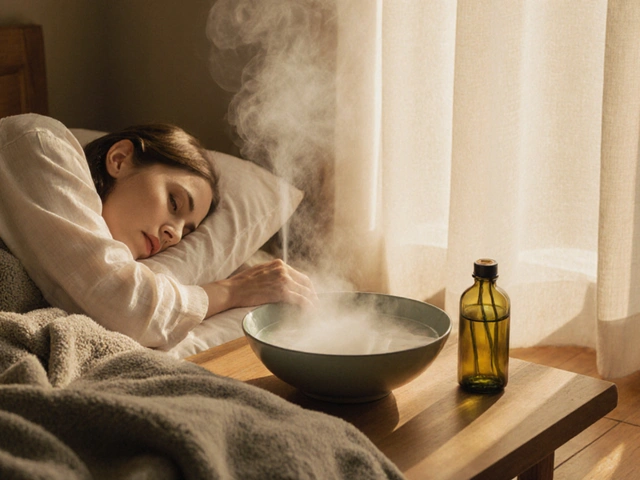You’re promised calmer nerves, better sleep, fewer headaches-just by breathing in plant scents. Sounds dreamy. But what does the science of aromatherapy actually say, and how do you use it without getting burned (literally and figuratively)? Here’s the straight talk: aromatherapy can help with stress, sleep, nausea, and some types of pain, but effects are usually small to moderate, not magical. Context matters, quality matters, and safety definitely matters.
TL;DR
- How it works: Scent signals hit brain areas for emotion and memory; some components act on receptors (like menthol on cold receptors). Expect subtle shifts, not instant cures.
- Best-supported uses: Short-term anxiety relief (e.g., before a procedure), mild sleep improvement, tension-type headaches (peppermint 10% roll-on), and nausea relief.
- Evidence caveats: Many studies are small; effects are real but modest. Expect inches, not miles.
- Safety first: Dilute properly (1-3% topical), limit diffusion (20-30 minutes), watch kids, pregnancy, pets, and phototoxic citrus.
- Quick wins: Lavender for pre-bed wind-down, peppermint roll-on for tension headache, ginger/peppermint inhaler for nausea, eucalyptus in the shower for stuffy days.
How aromatherapy works in your body (and why context matters)
Two things are happening when you use essential oils: your nose-brain circuitry reacts to odor, and your body responds to chemical components. Smell isn’t just a nice add-on-it plugs straight into the limbic system (amygdala, hippocampus), which tags experiences with emotion and memory. That’s why a whiff of lavender can nudge your nervous system toward calm, especially if you pair it with a relaxing routine.
On the chemistry side, different molecules have different targets. Linalool (big in lavender) likely nudges GABA-A receptors, which dials down neural excitability. Menthol (peppermint) triggers TRPM8 cold receptors-hello cooling and mild analgesia. 1,8-cineole (eucalyptus) has bronchodilatory and anti-inflammatory effects in lab and clinical settings; we have stronger evidence for oral cineole in respiratory support, while inhaled forms are plausibly helpful but less rigorously studied.
Delivery routes change the effect:
- Inhalation: Fast brain signaling via olfactory neurons; tiny amounts also enter the bloodstream through the lungs. Good for mood, alertness, nausea.
- Topical: Local action + slow systemic absorption. Best for muscle tension, headaches (temples/neck), and cramps.
- Ingestion: Strongest bioavailability but highest risk. Outside of specific medical products (e.g., standardized oral lavender in Europe), don’t ingest essential oils without a clinician who knows what they’re doing.
Placebo and expectation are not the enemy here. With smell, your brain’s prediction machine is in the driver’s seat. If you pair a scent with a wind-down habit-dim lights, slow breathing-you train your body to anticipate calm. That’s conditioning, not fakery. On a sticky Brisbane evening, the ritual itself can be the difference between a frantic mind and a settled one.
What the evidence says: where aromatherapy shines (and where it’s shaky)
Let’s keep it clean: aromatherapy research is growing but uneven. Still, several areas have decent support. Here’s the snapshot, with the kind of details that actually help you decide.
- Anxiety and stress: A 2019 meta-analysis in Complementary Therapies in Medicine pooling randomized trials found small-to-moderate reductions in short-term state anxiety, especially with inhaled lavender and citrus in medical and dental settings. Expect benefits in the moment (pre-procedure, bedtime), less so for chronic anxiety without broader therapy.
- Sleep: A 2021 systematic review (Complementary Therapies in Medicine) reported small improvements in sleep quality (PSQI scores) with inhaled lavender and similar oils across several RCTs, particularly in students and postpartum women. Bigger wins when used as part of a sleep hygiene routine.
- Tension-type headaches: Multiple German RCTs (e.g., Göbel et al., Phytomedicine, mid-1990s) showed that 10% peppermint oil applied to temples/forehead reduced intensity and was comparable to 1,000 mg acetaminophen in small trials. This is one of the clearest, practical wins.
- Nausea: Trials in postoperative and chemotherapy-related nausea show rapid, short-term relief with inhalation of isopropyl alcohol or peppermint oil; a 2012 emergency department RCT found isopropyl alcohol inhalation reduced nausea scores faster than standard antiemetics in the first 10 minutes. Peppermint and ginger oil inhalation can help, though effects may be modest and time-limited.
- Menstrual cramps: Several small RCTs report reduced dysmenorrhea with abdominal massage using lavender, rose, or blends (often diluted 2-3%). Helpful as an add-on to heat and gentle movement.
- Pain (general): Mixed. Some perioperative studies show small reductions in pain and opioid use; others show no difference. Consider aromatherapy supportive alongside standard care, not a replacement.
- Respiratory comfort: Eucalyptus (1,8-cineole) is classic in Australia. Stronger evidence exists for oral cineole as an adjunct in chronic bronchitis/COPD; inhaled use plausibly eases perceived nasal patency and cough irritation, but data are sparser. Avoid high-intensity diffusion around infants or anyone with reactive airways.
What likely doesn’t live up to hype? “Cures” for depression, serious infections, or chronic pain. Antimicrobial claims get tossed around based on petri-dish studies; those don’t translate cleanly to humans. Use aromatherapy for symptom relief and quality-of-life nudges, not as your only treatment for medical conditions.

Safe, effective use at home: doses, methods, and guardrails
Use simple rules. They’ll keep you safe and make your oils actually work.
Diffusion (inhalation)
- Start low: 3-6 drops total in a 100 mL water ultrasonic diffuser. For kids or pets in the space, use 1-2 drops and ventilate.
- Timing: 20-30 minutes on, then off for at least 60 minutes. Your nose adapts quickly; more time doesn’t mean more effect.
- Nebulizers (no water) are stronger; keep sessions short (5-10 minutes) and avoid around children, pets, or people with asthma.
Personal inhaler
- Add 10-15 drops to an inhaler wick; cap it. Inhale 2-3 deep breaths when needed (before a meeting, on a crowded train, pre-sleep).
- Handy for nausea (peppermint/ginger), acute stress (lavender/bergamot), and focus (rosemary/peppermint).
Topical (dilution matters)
- Face/neck: 1% dilution (about 6 drops per 30 mL carrier oil like jojoba).
- Body: 2-3% (12-18 drops per 30 mL). For tender areas (abdomen for cramps), stay closer to 2%.
- Kids (2-6 years): 0.5-1%. Infants: avoid unless guided by a clinician.
- Patch test: 1% blend on inner forearm; wait 24 hours.
Baths
- Mix 5-10 drops with a dispersant first (a tablespoon of carrier oil or a proper solubilizer). Never drop neat oil straight in-undiluted oil can stick to skin and cause irritation.
- Mind the tub-oils make it slippery.
Safety specifics
- Phototoxicity: Cold-pressed bergamot, lime, and bitter orange can cause burns under sun. If used on skin, avoid sun/solariums for 12-24 hours or use FCF (bergapten-free) bergamot.
- Pregnancy: Keep it simple and dilute. Many practitioners avoid strong oils in the first trimester. Discuss with your midwife/doctor; stick to gentle options (lavender, citrus) and low exposures.
- Children: Avoid high 1,8-cineole oils (eucalyptus, rosemary) around infants; for older kids, use low dilutions and good ventilation.
- Pets: Cats are sensitive to tea tree, eucalyptus, and citrus. Diffuse lightly, ensure they can leave the room, and skip topical use on pets unless your vet approves.
- Skin: Oxidized citrus and old oils increase risk of reactions. Store tightly capped, in dark glass, cool and out of sun. Citrus oils last 1-2 years; woody/resinous oils can last longer.
- Medical care: If you have asthma, epilepsy, or are on anticoagulants, get guidance before experimenting with strong mint, rosemary, clove, or wintergreen oils.
- Regulatory note (Australia): Most consumer essential oils aren’t TGA-approved medicines. Avoid products making therapeutic claims without evidence, and buy from brands that share batch testing (GC/MS) and botanical names.
Your practical playbook: recipes, checklists, FAQs, and next steps
Here’s the stuff you’ll actually use when you’re tired, tense, or queasy.
Quick protocols
- Pre-bed wind-down (sleep): Diffuse 3 drops lavender + 1 drop sweet orange for 20 minutes while you dim lights and read. Add 5 minutes of slow breathing (4-second in, 6-second out).
- Tension headache: Apply a 10% peppermint roll-on to temples, hairline, and neck; keep away from eyes. Repeat after 15 minutes if needed. Pair with a glass of water and a short neck stretch.
- Pre-meeting calm: Personal inhaler with lavender (8 drops) + bergamot (5 drops). Three slow inhalations outside the meeting room.
- Nausea: Inhaler with peppermint (8), ginger (5), lemon (2). Inhale as soon as nausea ticks up-earlier is better.
- Cramp relief: 2% blend in jojoba: lavender (6), clary sage (4), marjoram (2) per 30 mL. Massage clockwise on lower abdomen with a warm compress.
- Stuffy shower: 1 drop eucalyptus radiata on the shower wall away from face; breathe normally. Skip if anyone has reactive airways.
Heuristics that save time
- For mood: Flower + citrus (e.g., lavender + orange) is the easiest win.
- For pain: Mint + marjoram for muscle/tension; lavender for general soothing.
- If it smells wrong today, don’t force it. Your brain’s response is the point.
- Change the context, not just the scent-move, hydrate, dim lights.
What to buy (quality checklist)
- Latin name on the label (Lavandula angustifolia, not just “lavender”).
- Plant part and country of origin when possible.
- Batch or lot number and ideally GC/MS testing available.
- Freshness: pick smaller bottles you’ll finish; replace citrus yearly.
- Ethics: Prefer sustainably sourced oils (e.g., Australian sandalwood Santalum spicatum) and companies with transparent sourcing.
Common pitfalls (and simple fixes)
- “I can’t smell it anymore.” Olfactory fatigue. Run shorter sessions, switch oils, crack a window.
- Headache after diffusing. Too strong or wrong oil. Halve drops, try lavender or chamomile, and ventilate.
- Skin irritation. Dilution too high or oil oxidized. Drop to 1-2% and toss old citrus.
- No effect. Pair the scent with the right habit (breathing, light, hydration). Try a personal inhaler for a stronger cue.
Evidence-at-a-glance table
| Essential oil | Key constituents | Best-supported use | Evidence strength | Key safety notes |
|---|---|---|---|---|
| Lavender (Lavandula angustifolia) | Linalool, linalyl acetate | Short-term anxiety, sleep quality | Small-moderate effects in RCTs | Rare skin irritation; dilute; caution with very young kids |
| Peppermint (Mentha x piperita) | Menthol, menthone | Tension headaches (10% topical), nausea (inhalation) | Good for headaches; modest for nausea | Avoid near eyes; may aggravate reflux; not for infants |
| Bergamot (Citrus bergamia) | Limonene, linalyl acetate | Mood and stress relief (inhalation) | Small effects; supportive evidence | Phototoxic if cold-pressed; use FCF or avoid sun |
| Eucalyptus (E. radiata or E. globulus) | 1,8-Cineole | Perceived nasal openness, cough comfort | Plausible; stronger for oral cineole | Avoid strong diffusion around kids/asthma; keep ventilated |
| Ginger (Zingiber officinale) | Zingiberene, sesquiterpenes | Nausea support (inhalation) | Modest; more data for ginger root than oil | Skin warming; dilute well |
| Roman chamomile (Chamaemelum nobile) | Isobutyl angelate | Calm, sleep, childhood fussiness | Supportive but limited trials | Caution with ragweed allergy |
| Clary sage (Salvia sclarea) | Linalyl acetate | Menstrual cramp support | Small RCTs; helpful as adjunct | Use low dilutions; pregnancy caution |
Mini-FAQ
- Can I ingest essential oils? Not as a DIY project. Some medical products (like standardized lavender capsules) have evidence, but ingestion carries real risks. Talk to a clinician trained in this area.
- Are essential oils actually antimicrobial? In lab dishes, yes, many are. On skin or in rooms, it’s more complicated. Don’t replace handwashing or antibiotics with diffusion.
- Fragrance oils vs. essential oils? Fragrance oils are synthetic blends for scent; not the same chemistry or safety profile. For therapeutic use, stick to pure essential oils with known botanical names.
- How long should I diffuse? 20-30 minutes is plenty. Longer runs don’t boost benefits and may cause headaches.
- Are lavender and tea tree endocrine disruptors? A 2007 case series raised concerns, but later analyses haven’t confirmed a clear causal link. Use standard dilutions and rotate oils if you’re concerned.
- Which eucalyptus is gentler? Eucalyptus radiata tends to be softer than globulus for inhalation. Still go easy around kids.
Next steps
- Pick one goal for the week (sleep, stress, or headache). Don’t stack five at once.
- Choose one oil and one method. Example: lavender + 20-minute pre-bed diffusion.
- Track with a quick note: time used, mood/sleep score, any reactions.
- Adjust after 5-7 days: swap in a citrus or chamomile if needed; tweak dose down before you go up.
- When you find a winner, ritualize it-same time, same steps. Consistency amplifies the effect.
Troubleshooting by scenario
- Light sleeper, easily stimulated: Skip mint and strong cineole oils at night. Go lavender + chamomile at very low diffusion (1-2 drops total).
- Busy parent: Personal inhaler beats a room diffuser. Fast, portable, and kid-safe when used away from little noses.
- Pet household: Diffuse in one room with the door ajar; watch behavior. If your cat leaves immediately, that’s communication-listen.
- Hot climate (hello, Brisbane summer): Menthol feels great but can irritate if overdone. Use fewer drops and shorter sessions.
- History of migraines: Scents can be triggers. Start with unscented self-care (dark room, hydration), then cautiously test chamomile or very light lavender.
- Allergies/sensitive skin: Favor simple blends (1-2 oils), fresh citrus, and always patch test.
When to seek help
- Persistent insomnia, anxiety, or pain needs a proper medical plan. Aromatherapy can support, not substitute.
- Any wheezing, hives, dizziness, or swelling after exposure-stop and get medical advice.
- If you’re pregnant, breastfeeding, or managing chronic illness, run your plan by your clinician.
Bottom line: aromatherapy is a legit nudge, not a magic wand. Use the right oil, at the right dose, in the right moment-and pair it with the habits that make you feel human again. That’s where the science and the everyday win meet.







